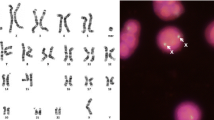Abstract
Investigation of marker chromosomes is one of the most challenging areas of clinical cytogenetics, especially in the prenatal scenario. A range of techniques including microdissection/reverse painting, SKY and M-FISH are available for the investigation of larger markers (>3 Mb). All these techniques rely on hybridization of unique, homologous sequences with simultaneous suppression of repeat sequences. In contrast, RxFISH is based on hybridization of cross-species syntenic sequences; repeat sequences do not hybridize due to species divergence. We have used RxFISH to analyse a group of the smallest, i.e. minute, supernumerary marker chromosomes. Our results suggest that even the smallest marker chromosomes often contain conserved pericentric euchromatin. More detailed characterization of pericentric genetic content is needed to assess the clinical significance of minute supernumerary markers.
Similar content being viewed by others
References
Amor DJ, Choo KHA (2002) Neocentromeres: role in human disease, evolution, and centromere study. Am J Hum Genet 71: 695-714.
Delatycki MB, Voullaire L, Francis D et al. (1999) Directly inherited partial trisomy of chromosome 6p identified in a father and daughter by chromosome dissection. JMedGenet 36: 335-338.
Horvath JE, Bailey JA, Locke DP, Eichler EE (2001) Lessons from the human genome: transitions between euchromatin and heterochromatin. Hum Mol Genet 10: 2215-2223.
Jackson MS, Rocchi M, Thompson G et al. (1999) Sequences flanking the centromere of human chromosome 10 are a complex patchwork of arm-stable sequences, stable duplications and unstable sequences with homologies to telomeric and other centromeric locations. Hum Mol Genet 8: 205-215.
Knight SJ, Horsley SW, Regan R et al. (1997) Development and clinical application of an innovative fluorescence in situ hybridisation technique which detects submicroscopic rearrangements involving telomeres. Eur J Hum Genet 5:1-8.
Milot E, Strouboulis J, Grosveld F (1996) Position effects and genetic disease. Trends Genet 12: 123-126.
Muller S, O'Brien PC, Ferguson-Smith MA, Weinberg J (1997) A novel source of highly specific chromosome painting probes for human karyotype analysis derived from primate homologues.Hum Genet 101:149-153.
Muller S, Rocchi M, Ferguson-Smith MA, Weinberg J (1998) Cross-species colour segmenting: a novel tool in human karyotype analysis.Cytometry 33:445-452.
Schrock E, du Manoir S, Veldman T et al. (1996) Multicolor spectral karyotyping of human chromosomes. Science 273: 494-497.
Speicher MR, Ballard SG, Ward DC (1996) Karyotyping human chromosomes by combinatorial multi-fluor FISH. Nat Genet 12: 368-375.
Schueler MG, Higgins AW, Rudd MK, Gustashaw K, Willard HF (2001) Genomic and genetic definition of a functional human centromere. Science 294:109-115.
Author information
Authors and Affiliations
Corresponding author
Rights and permissions
About this article
Cite this article
Hills, L.V., Nouri, S. & Slater, H.R. Pericentromeric euchromatin is conserved in minute human supernumerary chromosomes: a study using cross-species colour segmenting (RxFISH). Chromosome Res 11, 359–363 (2003). https://doi.org/10.1023/A:1024096024847
Issue Date:
DOI: https://doi.org/10.1023/A:1024096024847




